Getting someone to respond to an ice cold email in 2023 is very tough!
Tell me if you’ve heard this before:
“It’s 2023 – cold email is dead! 99% of cold email is spam. Forget about putting effort into cold email outreach.”
I’ve heard these complaints a lot over the last 5 years, but I respectfully disagree.
What makes me so sure?
Everything I’ve achieved in my career, I’ve achieved … through cold email:
- I scaled a startup from 0 to 40M page views and sold it to Google … through cold email.
- I’ve published 1400+ guest posts and articles in most well-known publications … through cold email.
- I’ve built relationships with Gary Vaynerchuck, Tim Ferriss, WordPress founder Matt Mullenweg, the Winklevoss Twins, on and on and on … through cold email.
- I grew this very blog from 0 to 20,000+ subscribers in two years enabling me to earn my first $100K from my PRThatConverts program … through cold email.
Just imagine:
You can finally build a business, land sales, and reach your goals … by mastering cold email.
In this article I’ll teach you how to write your own cold email with 30 specific examples of great cold emails, how they work and why, and all things about cold email strategy.
Ready?
Strap in.
(If you don’t have time to read the entire article you can listen to the audio version of it right here.)
Defining Cold Email
Cold email is any email sent to a potential client, potential customer, or other business contact with whom you don’t have an existing connection.
Here’s a simple way to think about it:
If you find a publicly-available email address for someone you’ve never met and send them a message, it’s cold email. Or …
If you email an influencer you’ve never met asking for feedback on an article, it’s cold email. Or …
If you and your sales team use a tool to find email addresses for your target customers and send personalized pitches introducing yourself, your product or service, and the value it would provide, it’s cold email.
Successful cold emails should include:
- Your real name.
- Contact info they could use to look you up: job title, website, social media profiles, phone number, physical address.
- Personalized, relevant content for the recipient.
- A specific request.
Good cold email outreach also:
- Is usually sent from one small business to another, or from one individual to a public figure (e.g, sales managers, journalists, influencers).
- Doesn’t always have a commercial motive, though in most cases it will be a sales email. You can send in an effort to establish a relationship.
Cold email is a one-on-one, personal conversation. That separates them from pure marketing emails, which are sent to large groups (and everyone knows it).
It’s like a cold call, but less intrusive and annoying.
Ultimately, cold email marketing is like sending an email to a business acquaintance, except the recipient doesn’t know you.
Is Cold Email Spam?
Here’s one of the most common questions I get from students:
“How is cold email different from spam?”
Cold email and spam are not the same thing — not even close.
Here’s why…
Spam:
- Often uses a fake name, fake email address, or other sketchy details
- Doesn’t include real contact information
- Is deceptive, saying anything to get you to open the email and take action
- Isn’t targeted (the same email is sent indiscriminately to a large list of people)
- Isn’t meant to start a conversation; rather, it’s usually aiming for a direct purchase (or something more nefarious)
- Has a pure commercial motive
- Gets filtered out by a spam filter almost automatically
For example, a few days ago I received this email:

Can you see all the telltale signs of an email destined for the spam folder?
This email doesn’t address me by name, and it’s not customized.
Did you notice that it doesn’t have a specific request? It’s just a generic, “Let me know if you’re interested.”
Also: There’s no contact information!!!! I have no idea who the senders are, or what they represent …
You can see why a spam filter will filter this out to a spam folder.
But even if it doesn’t wind up in my spam folder, I’m certainly not going to take action based on this email.
With all the SEO experts, firms, and workers out there in the world, am I really going to jump at this impersonal, vague, untrustworthy email? No chance.
Compare that example with another email:

Can you see the difference?
This good cold email does three things:
- It addresses the recipient directly.
- It has a highly specific and relevant request.
- And it mentions a common contact.
It’s likely to have far better email deliverability and wind up in the inbox, not the spam folder.
The ideal cold email outreach is not trying to push a product or get anyone on the phone for a long conversation.
The real world equivalent of this email would be like saying, “Hi,” to a friend of a friend you bumped into at a conference.
It’s not pushy.
It’s not annoying.
And it’s perfectly reasonable, as long as your call to action isn’t overly aggressive.
For example: “Buy my product!”
Sounds pushy, right?
But if you say: “Let’s get coffee sometime!”
That sounds a lot better.
Want a “sniff test” for spam vs. cold email?
Before you send out a cold outreach email, ask yourself:
Would I be comfortable saying this to someone I met at a conference for the first time?
If the answer is no, then it’s likely spam. If the answer is yes, then it’s a cold email.
Keep in mind that spam is illegal. Send too much spam and you will run afoul of CAN-SPAM laws in the U.S. (and similar laws in other jurisdictions).
Cold Email vs. Unsolicited Email
Unsolicited Commercial Email (UCE) is the official term for spam used by FTC.
And UCE can range from a sales email (like the example above) to a newsletter from a company you’ve never heard of before.
If you don’t want to break the law, you should know:
If you didn’t explicitly gain recipients’ permission to receive marketing emails with an opt-in form, and your email meets the spam criteria above, that email is an unsolicited commercial email (UCE).
Now… technically, cold email outreach is unsolicited as well.
However, if cold emails have…
- appropriate header information
- personalization
- and the offer of a relevant, targeted value proposition
… then, it likely won’t be considered UCE or spam.
Don’t Break the Law with Cold Emailing
Are you clear about whether an email falls under the CAN-SPAM laws?
It can be tricky. So let me break it down:
As per the Federal Trade Commission (FTC), all sales emails may contain three types of information:
- Commercial content, marketing emails that are selling a product or promoting a sale.
- Relationship or transactional content, like a bank sending a customer their bank statement, an eCommerce store sharing shipping updates, or a blogger sending a message to their list of opt-in subscribers.
- Other content, which can range from personal content to mixed (relationship + commercial) content.
According to FTC’s regulations, the purpose of an email decides whether it needs to comply with spam laws. If the email is primarily commercial — or is deemed to be so by the recipient — it has to comply with spam laws.
A well-crafted cold email marketing message might have a commercial tilt, but it also offers significant value.
How To Cold Email & Not Send Spam
Many organizations and people use some sort of identity theft protection and monitoring (such as Aura, Norton, Malwarebytes, or their many alternatives). It is very easy for anyone to manually mark any unsolicited emails as “spam” — in many cases the software does this automatically.
Once the software designates your email as spam (or someone marks it manually) you’ll be added to a blacklist — and have lots more email deliverability problems.
This software is designed to intercept emails like these below and make sure they go to spam:
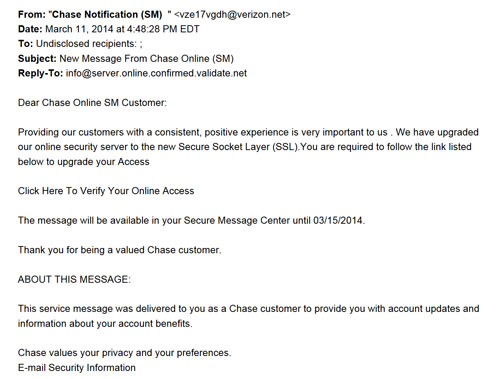
Here is another gem:
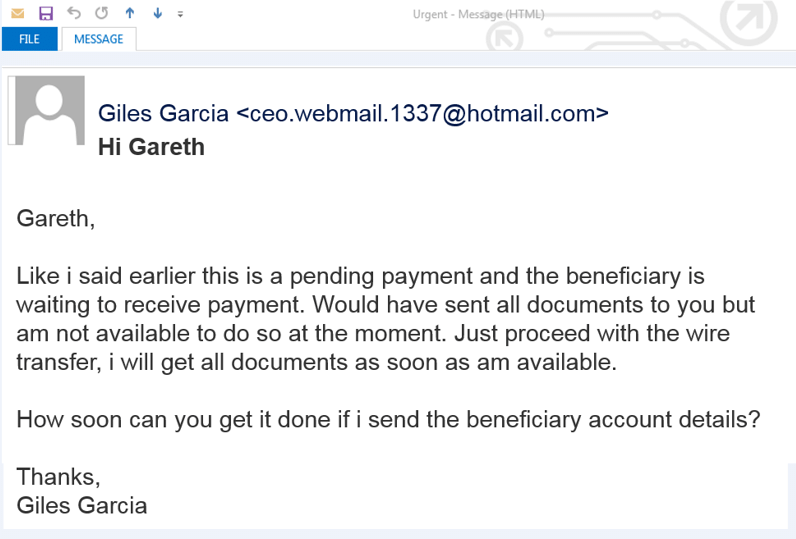
You can check if you are already on a blacklist by using the MXToolbox tool here.
You do NOT want to have your cold emails be classified as spam and have your emails reside along these above in the spam folder while your domain is on a blacklist.
The more of these best practices you follow, the less likely your email will be seen as spam.
Here are some quick tips to follow:
1. Use your real name and real email address
The “from field” tells the recipient where the email is coming from.
This is bad:

Always use your own name and personal email address. This shows that you are a real person, not a random small business sending unsolicited spam. There is a great guide I recently wrote on how to find anyone’s email address in under 30 seconds where I delve into email headers, recipient’s name and so forth.
2. Use the recipient’s first name
This is the easiest way to show that you didn’t just find a list of sales emails and spam them – use their first name.
A Hi {First Name} goes a long way towards making you sound more authentic.
However… there’s a lot more to personalization beyond merely including someone’s first name. And that’s where this next step comes in…
3. Make it relevant to the recipient
What’s one of the biggest indicators of spam emails?
They’re irrelevant.
Spam emails seldom address the specific needs of the recipient. It’s the same message to everyone, regardless of their needs, requirements or pain points.
Always ensure that your email offers at least one thing that’s relevant or valuable. Not only does that take you from “spam” to “cold email” — but it greatly improves your chances of a response.
4. Don’t talk about yourself too much
Know how to write a great intro?
Keep it short.
A long intro makes your email harder to read and it makes it sound like spam emails.
You don’t have to tell them that you are “John Doe from Acme Industries, the leading manufacturer of comically oversized gadgets for wily coyotes.”
Your cold email should focus on the recipient and their needs. When you talk about yourself, it should only be in the context of how you can help them (e.g., social proof, your track record, your results with similar businesses).
5. Match the subject line with the email body
Have you seen these subject lines in your spam folder:
“Heard rumors about you”
“Dear friend”
“Urgent! Please read!”
Avoid these at all costs.
Writing a great subject line is simple, just keep in mind:
Subject lines are meant to tell recipients exactly what they’re going to get in the email body.
6. Don’t use obviously copy-pasted text
Want to get sent straight to the spam folder?
Modern email clients preserve formatting when you copy-paste from one document to another.
See for yourself:
Try copy-pasting the last sentence to a new Gmail message.
If you have obviously copy-pasted text because of formatting, the recipients will be able to spot it from a mile away.
7. Add your contact info to the signature
Name, job title, phone numbers – these are the bare minimum you should have in your signature. If you can add a photograph or social media links, that’s great too. A physical address is also excellent for credibility and avoiding falling on the wrong side of CAN-SPAM.
Basically?
Show the recipient that you are a real person!
8. Track your emails
What is your open rate? Click-through rate? Reply rate?
Are you getting lower rates than you think you should on your campaigns?
It’s a sign that your copy or your value proposition isn’t any good.
Track your email performance, then:
Fine tune to improve delivery.
Cold Calling Doesn’t Work!
According to PFL, a maker of marketing solutions, cold calling campaigns have a measly 1% success rate.
Given how labor intensive they are, and how many rejections you have to endure to get one “yes,” it’s not a surprise fewer and fewer salespeople are making calls.
Cold emailing is a much more effective way to put yourself in front of prospects and nurture them into customers.
Here’s why cold emailing is a whole new ballgame.
Cold Emailing is Scalable
Sales prospecting takes a lot of time and concerted effort, from researching leads to tracking down their contact info. And then… it’s time to get in touch.
But you can only call one person at one time. With email, you can use outreach automation tools to create automated cold email sequences and nurture hundreds of prospects at once.
The other limit of cold calling is that you have to catch a decision-maker at the right time. They rarely return voicemails.
With email, you can stay on the first page of your prospect’s inbox for at least three to five hours, increasing your chance of getting noticed and opened.
How to send an automated cold email sequence to convert the maximum number of prospects into customers
In an effective cold email drip campaign or drip sequence, you write four to six emails ahead of time, leaving a few words and phrases to be personalized for each cold prospect, such as their name, where you found them, and what industry they work in.
Remember to write each email based on the potential customer’s perspective!
Be specific about how you can help your cold prospect solve a big problem for them.
You may already know this, but it’s easy to get stuck inside your own perspective as soon as you start typing.
For example, if you say, “My tool can help you rapidly build a targeted leads list.”
Then, you’re describing a feature instead of a benefit, and it’s from your perspective.
But, if you say, for example:
“Never worry about running out of new sales opportunities …”
Then, you’re describing specific benefits and how it can solve problems from your customer’s perspective.
Using an outreach automation tool like GMass (my personal tool of choice), you can connect to a Google Sheet of contacts, add emails in your sequence, and set up a schedule to send them.
Your email sequence and schedule can go something like:
1st day: Introduction email
There are many approaches you can use for the initial introduction email including:
Ask for a connection to the right person in the company
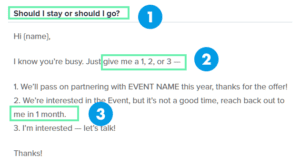
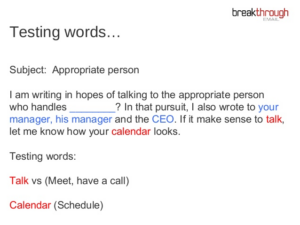
Source: Breakthrough Email
Ask the prospect for honest feedback on your product
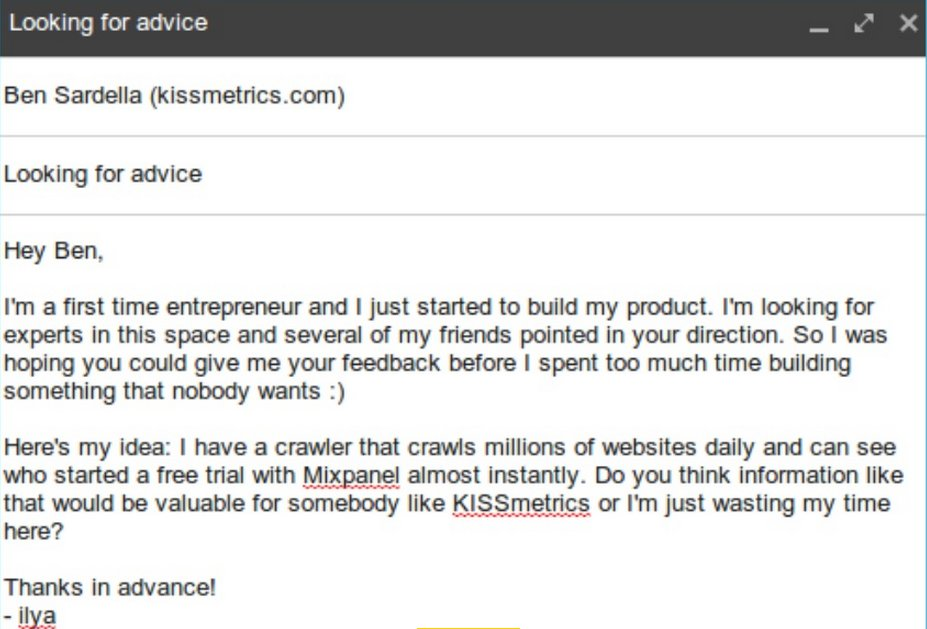
Ask if you can share a valuable idea to grow their small business
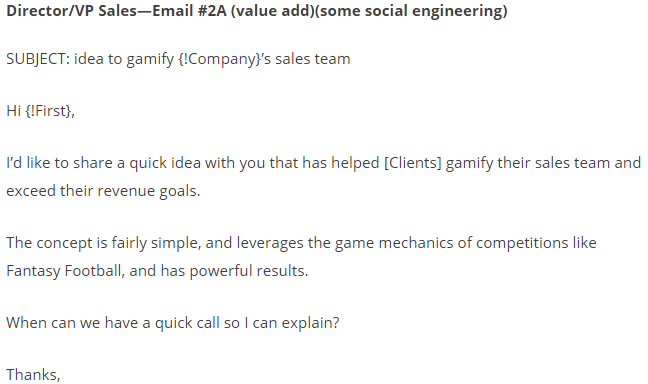
Source: Sales Hacker
Demonstrate how your company can help with a recent industry/competitor issue
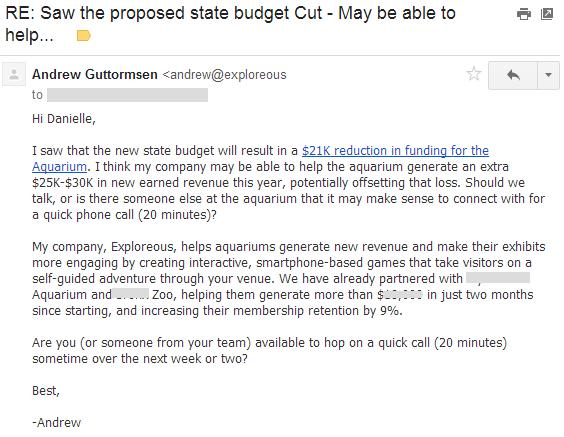
3rd day: Provide value or offer to provide help in a follow up email
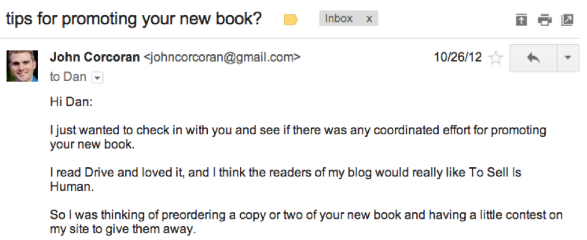
Source: Blogarama
5th day: Invite them to a relevant high-value webinar where you can demonstrate your expertise and skills
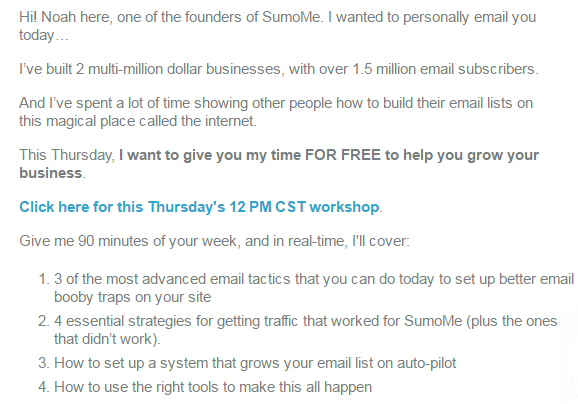
Source: SumoMe
8th day: “You’re welcome to pick my brain” email
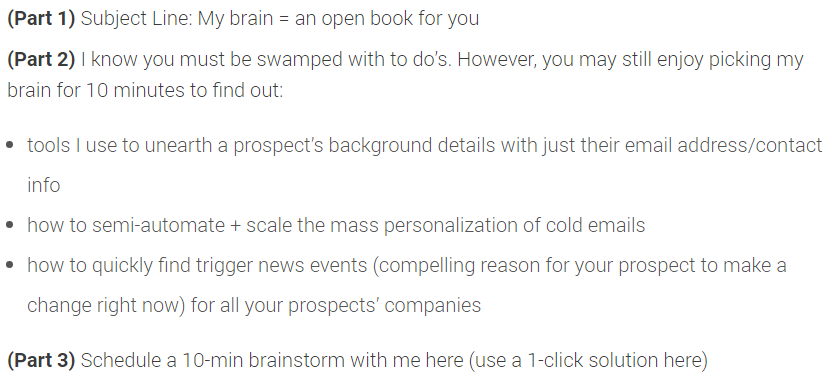
Why send a sequence instead of just a single email?
Many prospects require a few touches before you a) catch them at the right time when they can type out a reply or b) can get them to understand why it’s worth their while for them to reply.
When Heather Morgan of Salesfolk ran a cold email campaign for Ambition, they received responses as far along as the eighth, and last, email in the sequence!
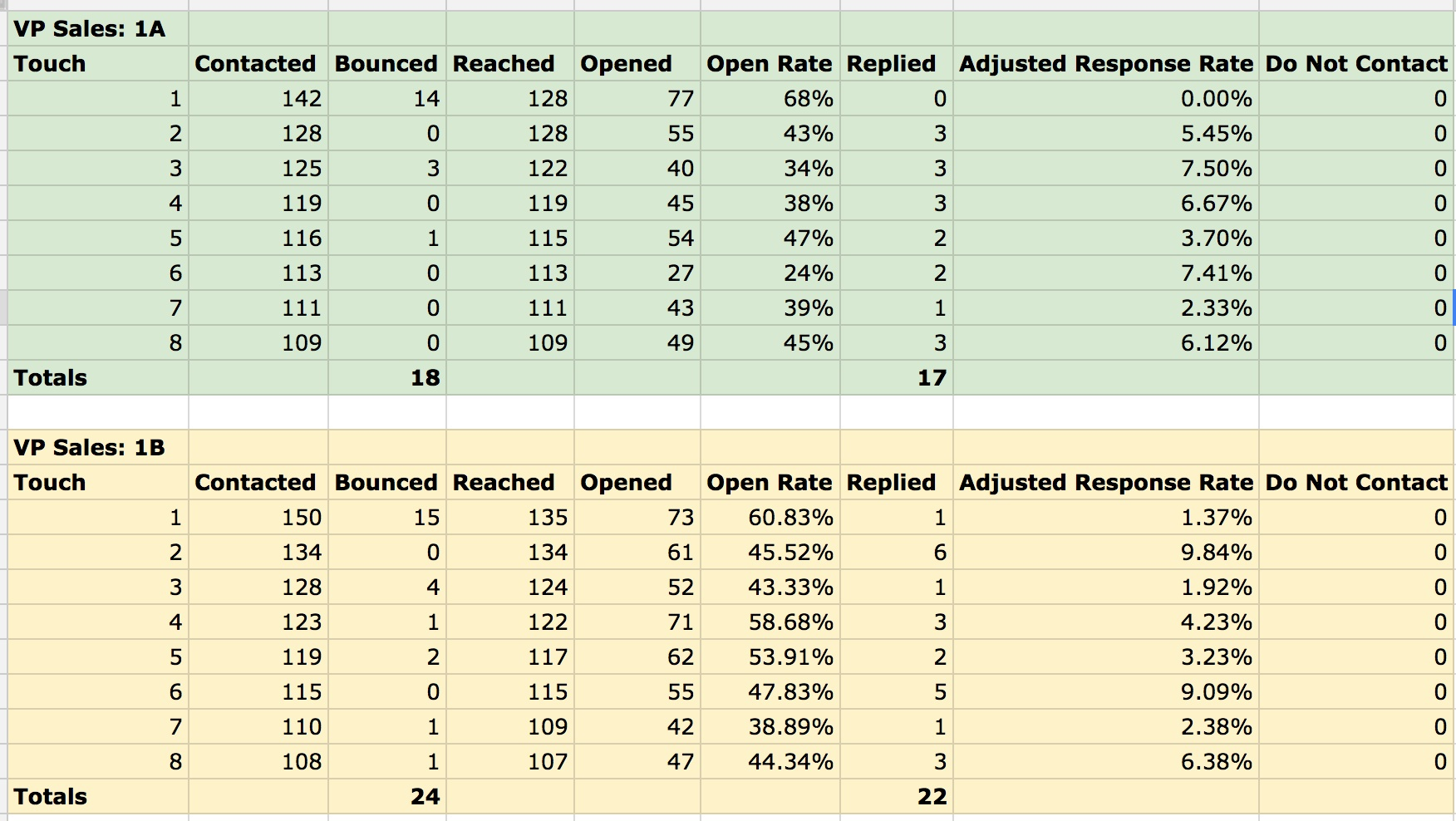
Cold email makes it easy to track your open rate and response rates
With cold calling, unless you call using special software, you have to manually input most of the data including how many callbacks you received and how many calls you had to make before you connected with your prospect.
Most cold email platforms can automatically track sends, open rate, link clicks and responses so you’ll know exactly how well each sequence is performing.
This also helps you analyze patterns that most often lead to closed deals:
- What send times got the most opens?
- How many touch points does it take on average to get your prospect to respond?
- Does it make a difference what sender name you use?
You can also A/B certain elements of your emails like the subject line or the calls to action to see what improves your response rates.

Source: GMass
It’s much more difficult to A/B test cold call approaches since many non-trackable variables can impact the success rate from your tone of voice to your choice of words (unless you read verbatim from a script every time).
It’s much easier to find (and guess) emails than phone numbers
Many companies do not publicly list the direct phone numbers of their employees. So it’s an uphill battle to convince gatekeepers to connect you.
With email, since most companies use predictable naming format like firstname.lastname@company.com or firstname@company.com, there are many tools that can “automagically” provide you a list of email addresses based on first and last names and the company they work for including:
There are three sales prospecting and outreach tools I like to use constantly. The way it works is that I input the URL of the company and the name of the prospect and the tool gives me their email address.
- Snov.io is my favorite for this since they also have an API which allows me to get contacts at scale.
- SalesHandy – In my humble opinion, SaleHandy is the best tool to put your email outreach on autopilot and actually get results by turning cold prospects into warm leads.
- AeroLeads –lets you add relevant people you find on LinkedIn to your leads list and finds their emails for you

If email searching software is giving you trouble, you can always try Googling “@company.com email”.
This sometimes turns up the email addresses of company employees published on a page and shows how their emails are formatted, so you can reliably guess the email of the person you want to reach at that company, if you know their name.
Example:


Based on that result, we can see that Salesforce formats their employee emails as:
firstiniitallastname@salesforce.com
Now that you have your prospects and your cold email tool, it’s time to send your messages.
The cold email template examples below will help you understand and master these best practices:
Score a $3K Contract Cold Email
My old coach and current friend Bryan Harris is a cold email outreach beast! Why?
His sales emails get incredible response rates!
Want to know the best part?
He shares his cold email templates to help you get the same response rate!
That’s how we have gems like this email:

Do you see what makes Bryan’s email great?
- Bryan clearly states that not only is he familiar with the product, but he’s also an ideal customer. (But only say this if it’s the truth.)
- He drops a big name right in the second line. By telling the reader that an industry leader, KISSmetrics, trusts his work, he is establishing respect.
- He links to an actual example of his recent work on the KISSmetrics blog.
- Offer value: This is where his email stands out from the other cold emails this target will ever receive. Bryan offers incredible value by showing what the final product might look like. Sure, it took an extra couple of hours, but by doing this, he ensures that he’ll at least get noticed.
- He closes with a question to spark a conversation, rather than jumping right into a big “ask.” This increases his chances of getting a response.
What can you learn from this
If you give away tons of value …
It means more work upfront for you and/or your sales team, but you’ll really stand out in the prospect’s inbox.
But I know what you’re thinking:
How can I apply Bryan’s techniques to my own emails?
Try this cold email template
I love [recipient’s company. I’m also a big fan of [compliment about a specific part of the recipient’s work].
I [what kind of work you do]. I work with [mention a big-name potential client, if you can].
Here’s an example of my work: [link to the best example of your work or favorite part of your portfolio].
I just wanted to email you to see if [recipient’s company] might be interested in something similar.
I made a demo to show you what it might look like here: [link to custom sample of work that you created upfront for the recipient].
Is this something you’d be interested in?
[Signature]
How to Blow Minds w/ Cold Email
If you’re familiar with modern digital marketing, you probably know Noah Kagan, formerly of Mint and Facebook, founder of AppSumo, SumoMe and OkDork. Noah knows his stuff.
He also gets hundreds of emails every month from people asking for his help.
The following cold email campaign, however, blew Noah’s mind.
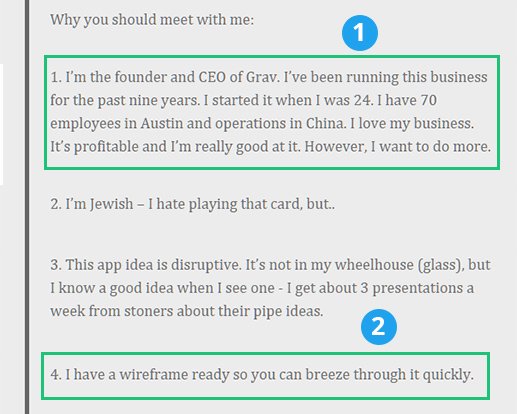
Noah has already done a pretty thorough breakdown of the email, so I won’t go into this in-depth. But there are a couple of things I wanted to point out:
- Successful people like to deal with other successful people. The sender, Dave Daily of Grav Labs, points out upfront that he knows his stuff really, really well. It might sound arrogant, but when you’re competing for the prospect’s attention of a busy person, you need to be upfront.
- Dave wanted to ask Noah about an app. So instead of fumbling around with an “idea,” he sketched out an entire wireframe. At a time when everyone and his grandma has an idea for an app, a wireframe alone means that you’re already way ahead of the pack.
It’s important to note:
The email is clearly about Noah — what he can get out of meeting Dave —not about Dave. This is a good practice to adopt in all your emails.
Also note the list format. There’s a reason why BuzzFeed works so well. People love to read lists, whether online or in emails.
What you can learn from it
Show that you mean business. A busy prospect’s inbox is no place to be shy. And to land a huge name, you likely need to do the extra work (like the wireframing in this example).
You can also get away with writing longer emails if you structure them well. As you can see in this example, lists and a clear focus on how your offer benefits the receiver make the email a fast and engaging read.
Follow these guidelines to write one yourself
Here are some guidelines to turn these cold email templates into winning emails for your business.
- Flatter the recipient in a genuine and honest way.
- Establish why your product/service will benefit them.
- Describe what makes you credible/successful.
- Suggest a specific and brief time frame for a meeting.
The Best Cold Email Pitch Ever
Didn’t I tell you that Bryan Harris is an absolute beast when it comes to writing a cold pitch?
Here’s one of Bryan’s emails, but from the perspective of the receiver (HubSpot).
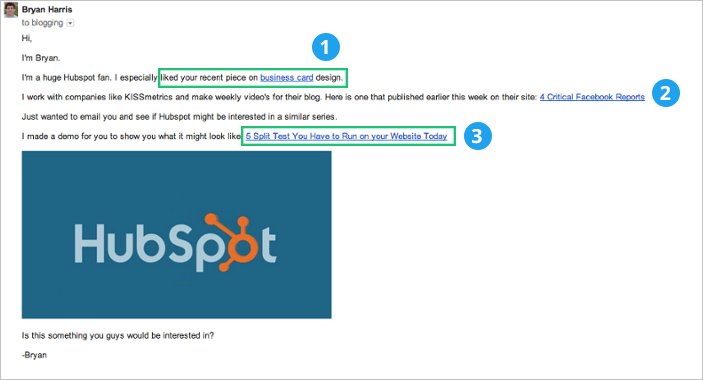
You’ll notice it’s the exact same cold pitch I discussed above, except this time …
It’s customized for Ginny Soskey, who manages content strategy for HubSpot.
Here’s the best part:
- By referring to Ginny’s latest post on the HubSpot blog, Bryan is telling her that he’s not just a random spammer. He’s actually taken the time to read the blog.
- One of HubSpot’s closest competitors is KISSmetrics. So mentioning them in the email helps catch Ginny’s attention.
- He doesn’t just share an idea — he makes an entire demo video. Making a video takes time. The free demo not only grabs prospect’s attention, but also gives HubSpot an idea of what the final product would look like.
What’s the result?
HubSpot was totally sold on the idea.
And Ginny announced it was the “best cold email pitch” she’s ever received in a blog post that has been shared ~2,000 times.
What you can learn from it
Personalize your cold pitch!
How do you grab a prospect’s attention?
Mention something the receiver did recently (check their blog or Twitter) in the first line. And make sure you’re genuine. Though this email just mentions the piece, citing a relevant takeaway from the article is better than a mere mention.
How To Land Meetings w/ Cold Email
Takipi is a tool that helps developers understand when their code breaks in production. It can be a tough sell to developers since it requires an installation on a live server.
Yet Iris Shoor, co-founder of Takipi, managed to get five installations from successful cold email alone — 1.5x more than what she got through introductions (without a sales rep or sales manager).
This is an example of an email she sent out to a company that used Scala:
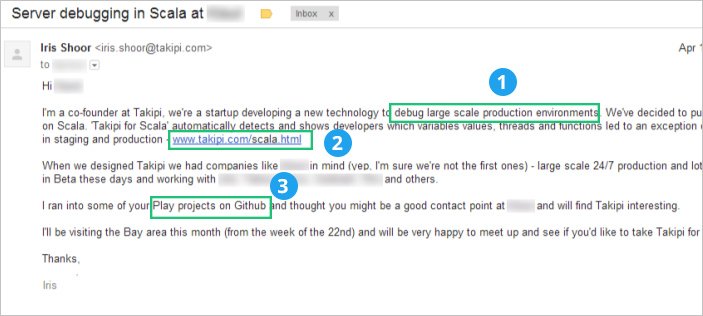
Lots of great stuff here:
- A nice, succinct intro. Iris gets right into what Takipi does and how it’s relevant to the company.
- Iris knows that the company runs Scala, so instead of sending them to the homepage, she linked to Takipi’s Scala-focused landing page.
- She mentions the recipient’s Github page and recent projects to show she’s done her homework.
What you can learn from it
Even though you’re sending a cold email campaign to (probably) multiple people, craft each email for one single person.
Don’t tell them anything they don’t need to hear …
Don’t mention anything that might be boring.
Instead:
Personalize your email for a particular person and explain how your product/service/company can solve that person’s problem.
Grab a Prospect’s Attention Cold Email
Scott from Life-Long-Learner.com shared an email that uses an interesting tool to create a powerful visual message.
Here’s the example of his successful cold email templates from his blog:
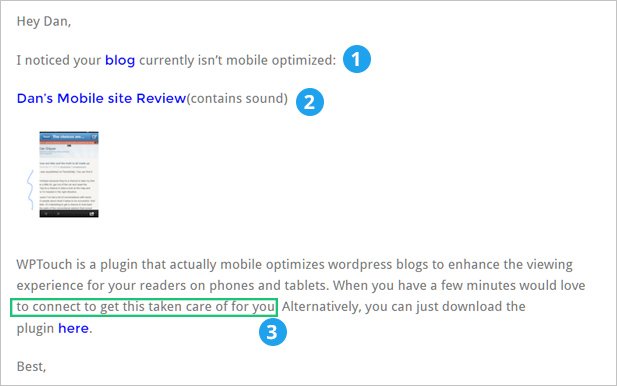
Scott has a breakdown on his own blog, but here are his most important points:
- Scott jumps right in without an intro. That grabs the recipient’s attention and doesn’t waste time focusing on Scott.
- Scott doesn’t send a long email with a list of everything wrong with the mobile version of the blog. Instead? He creates a visual presentation that depicts what’s wrong (again: show, don’t tell). Also note the little sound warning — a nice touch, and one that makes it clear this is a video/audio walkthrough.
- Scott gives value by offering to take care of this problem for Dan. This could turn into a paid contract and a fruitful, long-term relationship.
What you can learn from it
Remember: Show, don’t tell.
Instead of writing a 500-word email filled with abstract ideas, create a video or presentation that shows your ideas in action.
Win Over a Founder Cold Email
This is a great cold email campaign from Sam Parr, founder of HustleCon, a startup event for non-tech people.
It’s incredibly well-crafted with extensive personalization.
And yes, hours of work went into each email, but when you consider the rewards …
It was time well spent!
Here’s the email:

This email is different right from the very first word. It eschews all conventions and is just… fun.
It’s a hustler’s email, which is exactly what HustleCon is all about.
Here are the best parts:
- Love it or hate it, you can’t ignore that first line (reminder for marketers: what doesn’t stand out gets forgotten). Sam mentions Rick Marini’s (founder of BranchOut) past and the $200k job he turned down. That fact isn’t readily available, which means Sam is legitimately a fan. He comes across as authentic as a result.
- Sam drops the key info all bundled up in one sentence.
- Sam plays to Rick’s ego by telling him that he can come over and spread the “Marini gospel.” He knows that entrepreneurs who’ve reached Rick’s level of success care more about influence and spreading their ideas than making money.
- He doesn’t write a 500-word explanation. Instead? He links to a page that tells Rick more about the conference.
Sam also made these fun GIFs for all the recipients.
GIFs are a great way to personalize your message without being stuffy and corporate-y.

What you can learn from it
Have fun!
And mirror your brand’s image in your language.
If you’re branding yourself as a fun, youthful alternative to stuffy conventional conferences, don’t use the same stuffy, conventional language in your emails.
Score an Interview Cold Email
John Corcoran was a writer for the Clinton White House, so you bet he knows a thing or two about high-stakes writing.
John wrote a piece in the Art of Manliness where he mentioned Noah Kagan.
For a follow-up, he wanted to interview Noah about the importance of failure.
How’d he do it?
With this email:
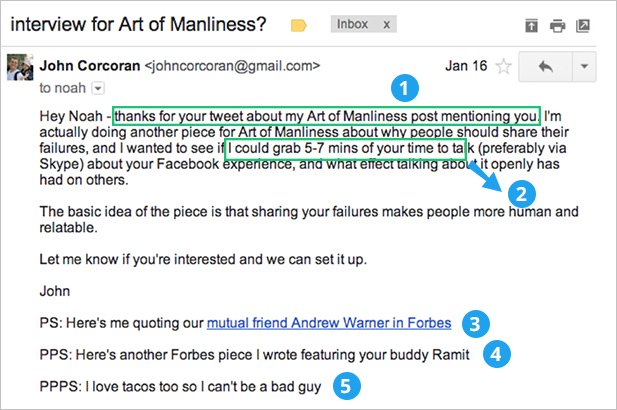
Now there’s a whole process before this email (covered here), but the email itself has lots of gems:
- John mentions the recent interaction he had with Noah on another platform. That’s a great way to warm up a cold email.
- It’s important to reassure a busy person that you won’t take up half their day — or even half an hour — with a request. John clears this upfront by mentioning the interview will take 5-7 minutes.
- John mentions Andrew Warner, of Mixergy, and his recent Forbes post. How does this help? It establishes that John and Noah have a common contact. And it validates John, since his work has appeared in a reputed publication like Forbes.
- More namedropping.
- John knows how much Noah loves tacos.
What you can learn from it
You can use this example, too, if you can mention a common connection.
Remember: Even a distant connection is better than no connection.
Kickstart a Relationship Cold Email
This email from Sidekick is simple, clear and well-thought out. It isn’t designed to do anything fancy or win over celebrities to speak at your gig. Instead, it focuses on conversion rate — i.e., driving leads and relationships further down the sales pipeline.
Take a look:
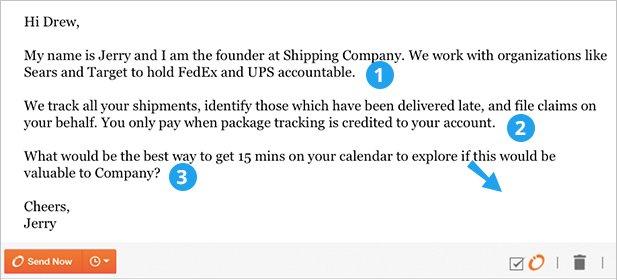
There’s nothing fancy going on here, but you’d be surprised by how many B2B sales folks or just a salesperson or a recruiter even gets it wrong.
This example is short, crisp and clear — exactly what you’d want in a B2B email.
- A clear, simple introduction. Use a familiar example: People might not understand what “logistics accountability” is, but they definitely understand FedEx and Target.
- The email focuses on benefits, not features. There’s no mention of any fancy tracking algorithm or smart platform. It’s all about how they can save the recipient time and money!
- The cold email campaign ends by asking for 15 minutes, a reassurance to a busy person.
What you can learn from it
Focus on benefits instead of features.
This rule applies to everything – landing pages, sales letters, emails.
Land a $15K Project Cold Email
Lots of successful cold emails are all about writing the perfect pitch or personalizing the email to the extent that the cold prospect just can’t ignore it.
This cold email template from Masswerks, however, focuses on what you can achieve if you target the perfect audience.
Take a look at what a good fit for the ask and target audience looks like:
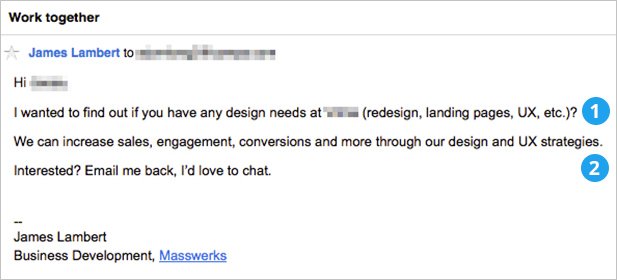
Looks like nothing special, right?
It has three lines, a simple subject line, and no fancy gimmicks.
Yet, it got Masswerks a $15K consulting gig. Why?
Because they focused obsessively on targeting the perfect potential client.
You can read about it on the blog post linked above, but here are the most important takeaways:
- Masswerks targeted growing companies that had already raised some funding. These businesses have their hands full and usually need help with UX and design work. Since these businesses are already looking for help, the opening line works like a charm.
- A brief overview of what Masswerks can do: increase sales, engagements, and conversion rate. The sales process is built around these three metrics: sales, engagements and conversion rate. It would be even better if they could provide examples of these (case studies, or even a stat) — but with this highly-targeted audience, their email was still successful without.
What you can learn from it
Choose your targets wisely.
You can do a lot with a simple email — if you send it to the right group of people.
Don’t skimp on your homework …
Research your ideal customer thoroughly before you even send an email.
Grab Potential Customers Early Email
This one-paragraph message from Ash Maurya is chock full of wins.
It ticks all the right boxes:
It’s succinct, it’s targeted, it’s personalized, and it has a clear objective.
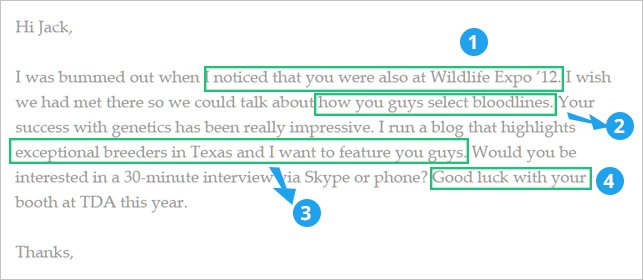
Everything I love about cold email templates like this one:
- Ash mentions he saw the recipient at an event. This establishes a connection and proves you probably share the same interests and passions.
- Further establishing shared passions: Someone who breeds horses would love to talk about how they select bloodlines.
- Flattery works, and there’s lots of it here. It tells the recipient(s) that they are among the most “exceptional” breeders in Texas and states they’re “impressive.”
- Closes with a specific request for a phone call, plus a mention of the recipient’s future activities. This again hammers in the fact that you aren’t a creepy sales guy who’s just out there to land a deal. Instead, it establishes the fact that you’re a small business owner who has a common interest — and you want to feature them.
What you can learn from it
Don’t be a slimy sales guy! How?
Be human.
Show you care about the people you email …
Tell them about your shared passions and interests.
Remember:
Your objective is to build relationships, not just close deals.
And it helps if your first contact is an email like this where you’re offering pure benefit to the recipient, not asking for something from them.
Connect With a Pain Point Cold Email
Yep, this is the third reference to Bryan Harris in this article.
I said he is an absolute beast, right?
In this blog post on his site, Bryan shows how to use data to create a targeted email list of prospects. Then?
He sends each prospect a clear, straightforward email about how they can make their small business better.
To flip things up, though, he shared an email he received using this cold email strategy from Nathan Barry, founder of ConvertKit:
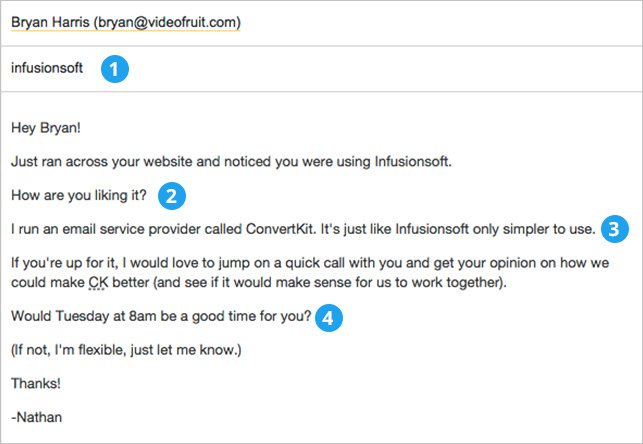
The hard part is creating the email list of prospects, but Bryan’s blog post goes pretty deep into that so I won’t cover it here.
Rather, I’ll focus on the best parts of the email:
- The subject line is a single word: InfusionSoft. Since Nathan’s list of contacts is targeted (bloggers who use InfusionSoft and therefore might just be tired of its complexity) this one-word subject line will stand out in the prospect’s inbox.
- “How are you liking it?” If you’re a blogger who uses InfusionSoft, Nathan’s willing to bet you probably aren’t overjoyed about using it. This single line is a great way to bring the reader’s attention to the issue, without stating it outright.
- The actual subject line of the email: The alternative to InfusionSoft that’s simpler to use.
- Offering up a specific date and time for a call. Saves several back-and-forth emails to decide a meeting time.
What you can learn from it
Once again, an effective cold email campaign is simple:
Address the customer’s primary pain point.
Tell them how you can solve it.
Then, propose a time for a short meeting where you’ll provide that solution.
Start a Relationship Cold Email
Before I share this PR cold outreach campaign example, if you need to find a PR outreach tool head over to this article on the best PR tools.
The cold email outreach below is a great way to kickstart a relationship with a blogger or journalist.
It references their past work, directs them to something that might interest them (based on their past work), and opens the possibilities for a longer conversation.
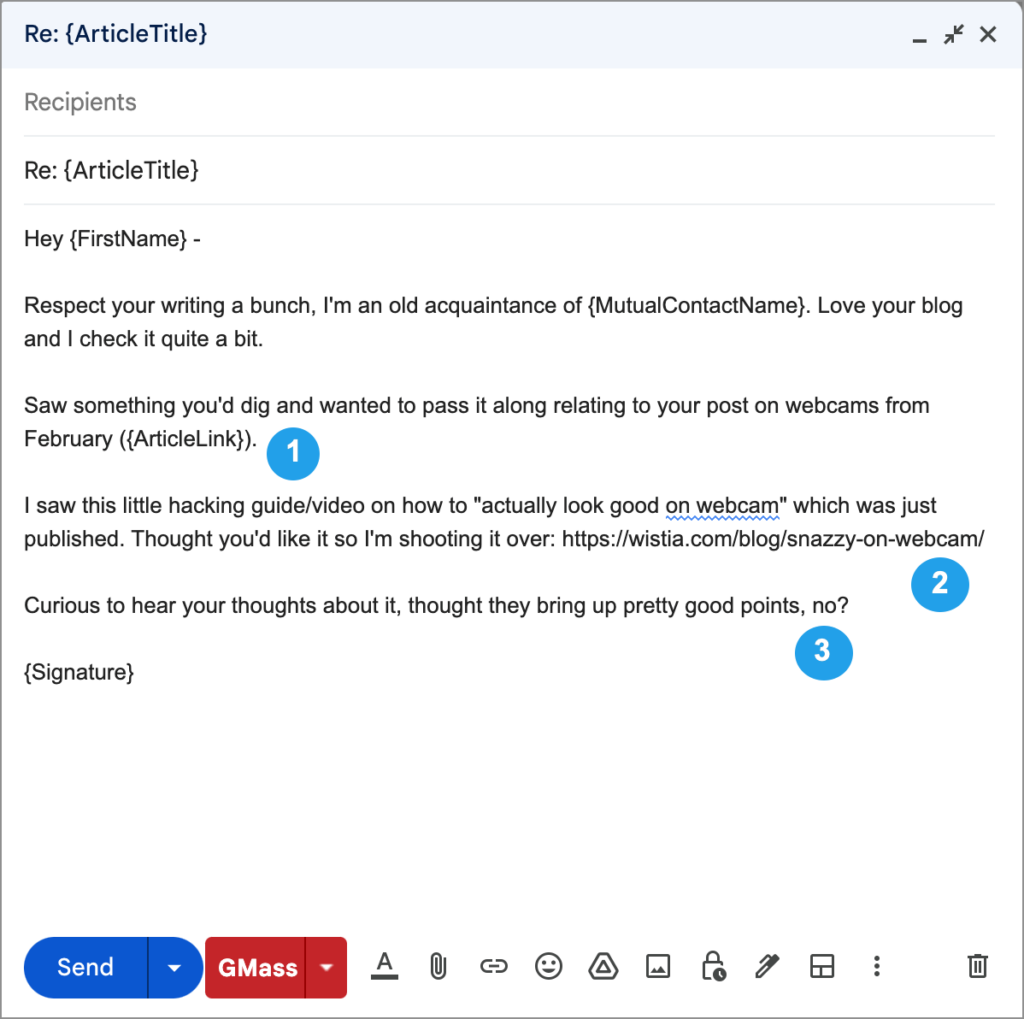
Here’s what I love about it:
- The first paragraph references their recent work, showing the sender really is a fan.
- The second paragraph brings the recipient’s attention to a related topic and plugs a related blog post. (Ideally it’s somebody else’s blog post, since your only objective is to start a relationship — not try to get a link or a reader.)
- The email ends with a question, which opens up the chance for a longer conversation.
What you can learn from it
Journalists and bloggers care about their work.
By referencing their recent work and directing them to something similar, you show that you care about them, and that you have similar interests.
Over time, this can help you develop a relationship.
Help Someone Out
There was a trend for a long time with cold email link builders where they’d offer up their link to “improve an article.” That’s… not really true in most cases, and those emails rarely worked. Writers rarely care about adding a semi-related link to a five-year-old article.
But writers do care about their typos. A ton.
So one of the absolute best ways to get a conversation going with a writer is… point out typos and grammatical errors.
You’ll be surprised how effective this can be, especially with writers who take their work seriously.
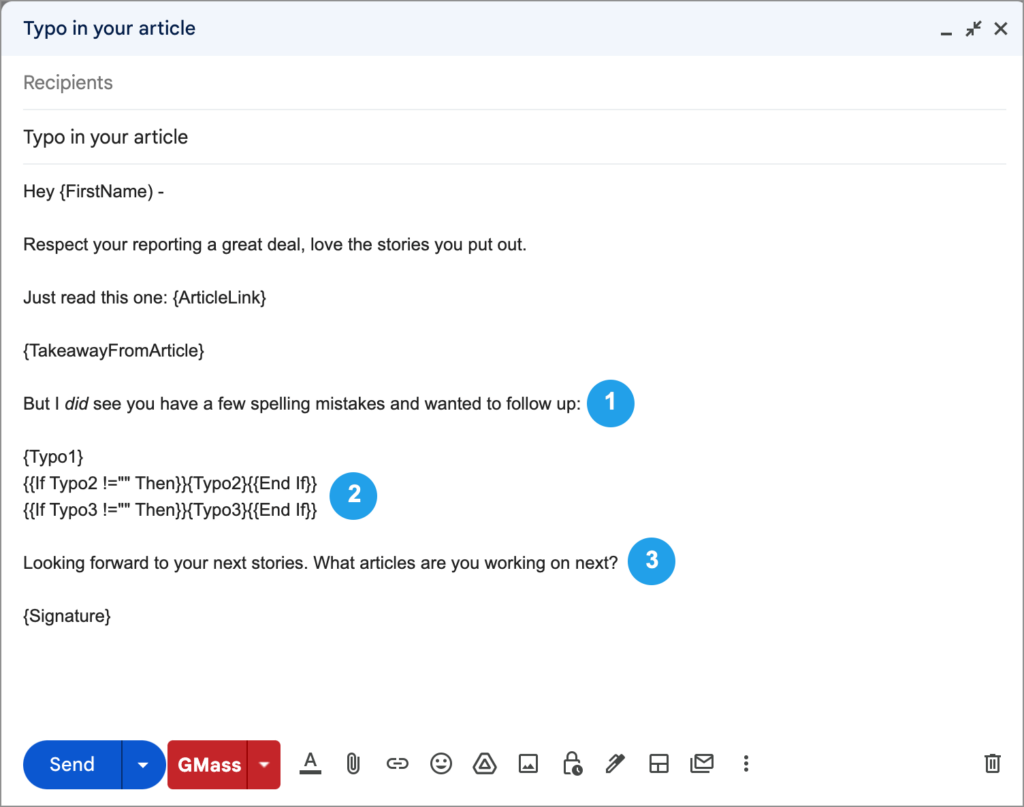
- Warning! People can be touchy about their grammar. Instead of saying “your grammar is wrong,” be friendly and polite.
- If your email app allows for it, you can use conditional formatting here to automatically include up to three typos per journalist. This is a great way to send these emails at scale. (My formatting here is from my cold email app of choice, GMass. I’ll talk more about why I use GMass later on in this article.)
- Asking what the journalist is working on next is a great way to continue the conversation.
What you can learn from it
Provide real value a journalist cares about and they’ll appreciate it. Odds are they don’t care about adding a link to your blog post — that serves you, not them, no matter how you try to spin it as “being helpful to their readers.” Pointing out a typo provides value to them.
Then build the relationship by asking what they’re working on next.
Use a Hook in a Cold Email
There’s nothing influencers and writers love more than knowing how their strategies and tactics have helped others.
Share your results with them, and they’ll be happy to spread it to their fans and followers.
It establishes a great connection and it gets them great press!
Here’s a simple template:
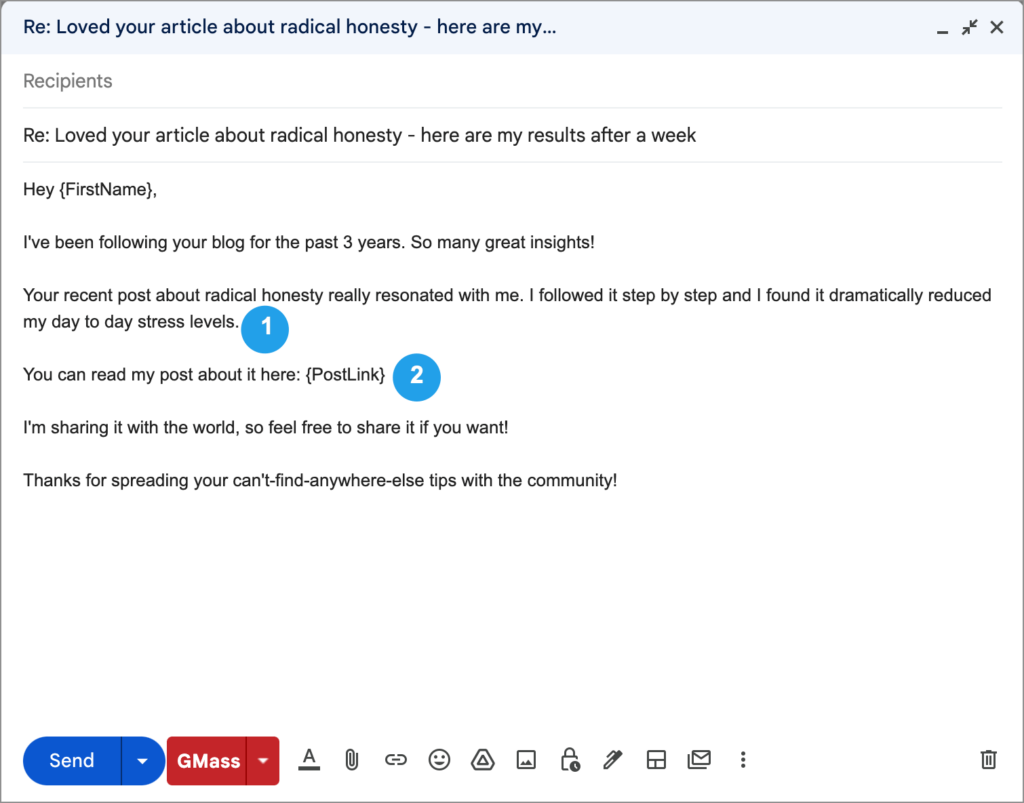
- Mentions the recent post, states how you’ve been following it, and how it has affected your life.
- A link to the post, along with a subtle suggestion that the influencer can share it with their target audience.
What you can learn from it
If you’ve ever followed any influencer’s advice, share your results with them.
It’s one of the best hooks for building a relationship with them.
Get Published Cold Email
For this example to work, you need two things:
- An interesting story
- And a person willing to tell it
The former is something I can’t help you with.
For the latter, monitor your Twitter feed, or start conversations using some of the templates above to see if there are any writers, bloggers and journalists looking to cover stories similar to yours.
Then, send them this email:
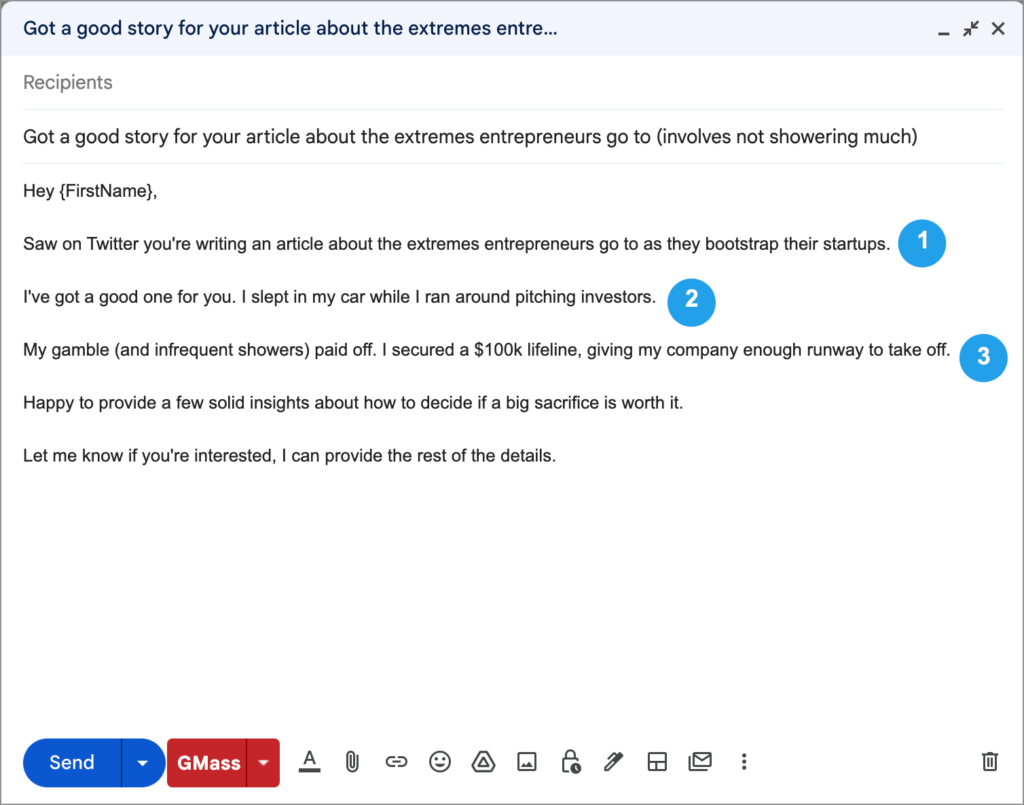
- Mention how you found the story idea — on their blog, via email, or on their public Twitter feed.
- Share the basics of your story in as few words as possible.
- Tell them how this ties into the topic they wanted to write about. It’s best if you can show your story has a beginning, middle, and end — that’s what they’re looking for.
What you can learn from it
Writers and journalists love it when they can get a personal, human angle on a story.
If you know journalists who are writing about a topic that you have relevant experience with, it’s a great idea to pitch them stories.
Win a Backlink Cold Email
This is one email every marketer has to send sooner or later: a backlink request.
Here’s how to do it right…
The first step, of course, is to ensure that you have top-notch content.
Then, find a list of people who link to resources similar to yours, and send this email:
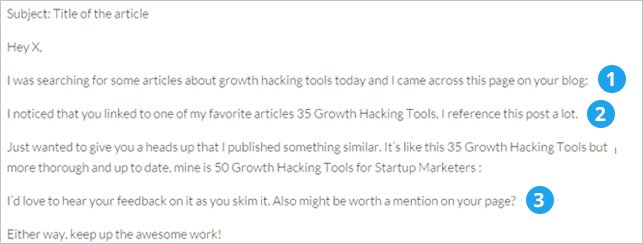
Here’s why this email works:
- Clearly mentions the specific post and how you found it, social proof, search, etc.
- Links to the reference post that you improved on (aka the ‘Skyscraper method’).
- Asks for feedback, then puts a subtle plug for a backlink.
What you can learn from it
The best way to get a backlink is to improve an existing resource.
Then, ask all those who’ve linked to it to take a look at your improved resource – and perhaps give a backlink in return.
Nail a Sales Call Cold Email
If you’re in B2B sales (say you’re a salesperson or a sales manager) or you’re one of many B2B marketers at your company — you’ll have to make dozens of calls every day.
This example sets you up for more yays than nays:
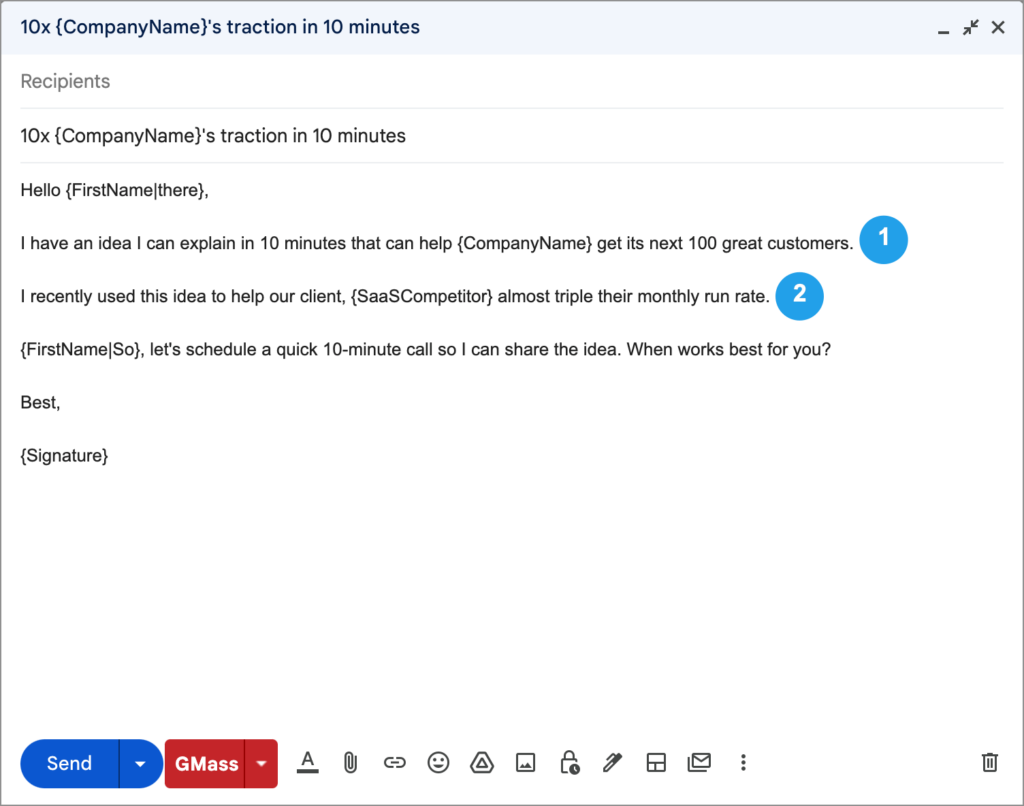
- It asks for just 10 minutes. That’s good enough for most busy people. And what company wouldn’t want 100 more great customers?
- It name drops a close competitor or industry leader, and shows the results they got from working with the sender.
- It’s a very simple three-line email, but if someone credibly promised to get you 100 more customers and asked for just 10 minutes of your time, wouldn’t you be interested too?
What you can learn from it
Tell prospects exactly what kind of results they can expect. Then…
Tell them how long you’ll take to achieve it!
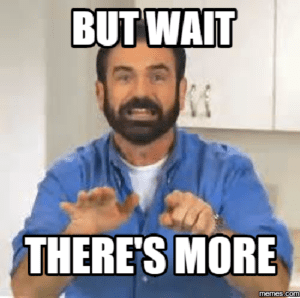
Cold Email Subject Lines That Work
I included subject lines in the examples above, but here’s an even deeper look into that ever-important element of cold email outreach.
Subject line should entice your prospects to open your email. The holy trinity of a good subject line:
- short (8-10 words max)
- use a casual tone (prospects do not want to read an email that sounds like it came from their lawyer)
- not deceptive (if they feel you tricked them into opening, they won’t respond, and it sullies your company’s reputation)
Here are a few high performing subject line formulas to use as a reference
For initial introduction emails
- [Colleague] recommended I get in touch. If you use the “appropriate person” email template shown above, you can mention the name of the colleague who referred you in your subject line.
- A few ideas [to resolve their biggest pain point related to your product]
- 10x [prospect company]’s [area they would want to grow – example: sales, user retention]
- I found you through [Name]. To be able to use this subject line, see what mutual connections you share with this prospect on LinkedIn and mention one of them in the title.
- Congratulations on [recent good event that happened to their company]
- Been following you on [site where they publish content] and wanted to reach out
- Are you the right person to speak with?
- Saw you use [complimentary product] – you may find this interesting
- A new [area that your product is in] strategy for [Company]
For follow up emails
- My brain is an open book for you
- Should I stay or should I go?
- Can you blame me for swinging for the fences 🙂
- Re: subject line of your first email. Only do this for one of your follow-ups.
- Saw that [event relevant to their industry/company or something the prospect recently did]
More Cold Email Resources
I promised you tons of email resources…
And I’m not going to back out of that promise!
I’ve covered tons of examples with cold email templates here.
These will help you craft great cold emails of your own.
And don’t forget you can get 15 more templates here, too!
But, if you want even more help writing an amazing email?
Don’t worry, I’ve got you covered!
Here are more go-to resources and related articles for writing effective cold email:
1. How to get early customers to respond to your emails
Feedback from your early customers is vital to your product’s success.
However, not all early customers are that eager to respond to a cold email campaign. This link to LeanStack will help you with that.
2. How to write a great email to a cold lead
It doesn’t matter whether you’re a freelancer, a marketer, or a founder, you’ll have to send out emails to cold leads if you want to grow your small business.
This link gives a great overview of how to write an effective email that can win you deals.
3. How to write an email that doesn’t suck
93.9% of cold emails suck.
This is what Anand Sanwal of CBInsights discovered after analyzing 147 cold emails. Read this post to figure out what makes a bad cold email, and how to write a good one.
4. Seven sanity checks for sending emails out
You’ll want to read this post before you hit send!
5. Quick tips on how to write a subject line for sales emails
The subject line is the single most important part of any cold email. Read this post to get it right the first time!
6. 15 commandments for every email sequence
Read this to learn the 15 rules you must follow before sending out a cold email. I love the advice about mentioning competitors and mirroring your target’s tone.
7. Email Signature Perfection: Should I Buy One or Create One?
This link shows you why email signatures are the most neglected tool in daily communications and how to ensure yours is effective.
8. How To Write a Follow Up Email?
Making first contact is the hardest part. But once you’ve achieved that, what do you do next? Read this post for a comprehensive guide to follow up emails, covering a huge range of different situations and use cases.
So there you go – lots more resources to help you master great cold emails.
Cold Email Software: How to Choose Your Platform
I’ve tried lots of different cold email software platforms. The one that I now use exclusively for all my cold emails is GMass.
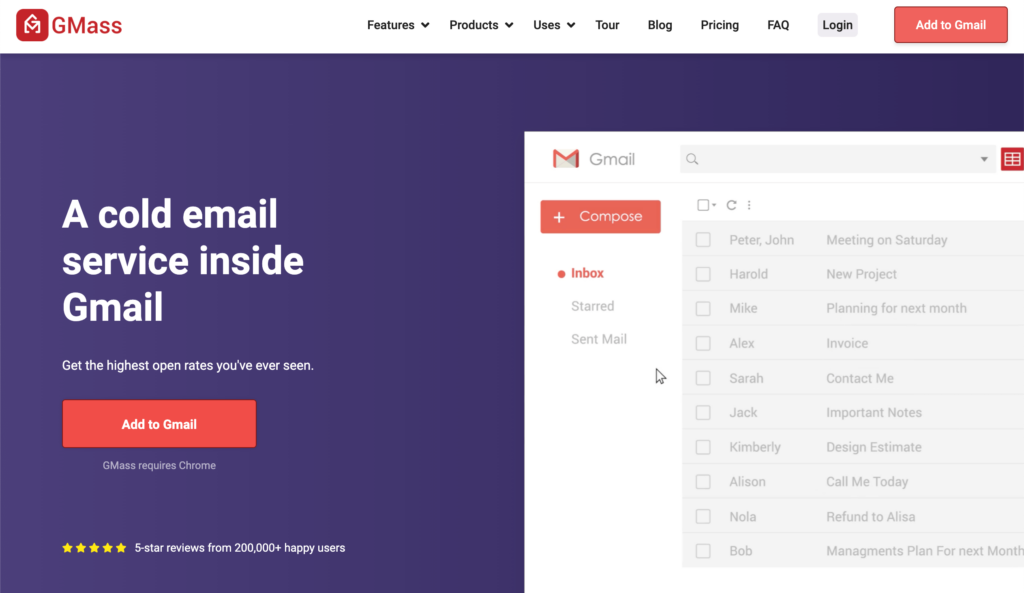
Here’s their list of reasons why GMass is different from the other cold email platforms, but here are my reasons for choosing it:
- It works inside Gmail, which makes it fit right into my email workflow. I’m not sending campaigns from a different website then replying in Gmail, it’s all happening there.
- GMass has the best email deliverability of any of the platforms I’ve used. Their emails go through Gmail’s servers, plus they have a bunch of email deliverability tools like free email warmup and a tool that predicts whether your campaign is destined for the spam folder (and how to fix it).
- They do the best job of making mass emails feel like personal emails — which get a better reply rate. GMass’s mail merge features are great and they have lots of little extra features too. I really like that they give you the chance to send follow-ups as plain text replies to your previous emails to a contact.
- And on top of that they have the best pricing of any cold email service! Plus a great free plan too.
I’d recommend giving GMass a try. My goal is always to spend more time on cold emails and less time figuring out the perfect software to send it. So this should save you some time!
Bonus: Cold Email Pro Tips!
- Use a note taking app such as Notion or Monday to keep track of your cold email financial performance – that is: how much did you spend on the campaign and how much did you make. It’s important to not only focus on opens and clicks but also know how you’re doing financially.
- Create a separate email address on a separate domain similar to yours from which to send your cold email campaigns and use cold email software to scale your cold outreach campaign. (For instance, if your primary domain is a .com, get the .net for sending emails.)
In case you get flagged by a spam filter, get any spam complaints, or servers flag you for sending a lot of similar emails at the same time, this protects the sender reputation and email deliverability of your primary email.
- If you can find this data point on your prospects easily, separate your prospects into different lists based on their time zones.
This way, for example, you can time your emails to go out exactly at 10 AM their time.
Without accounting for timezone, they may get your cold email at dinner time — or worse, in the middle of the night — and miss it entirely.
- Make it easy for anyone to schedule a call with you in one click.
For example, Calendly lets you set what times you’re available and your prospect can instantly book a free time with you, eliminating the need for any back and forth.
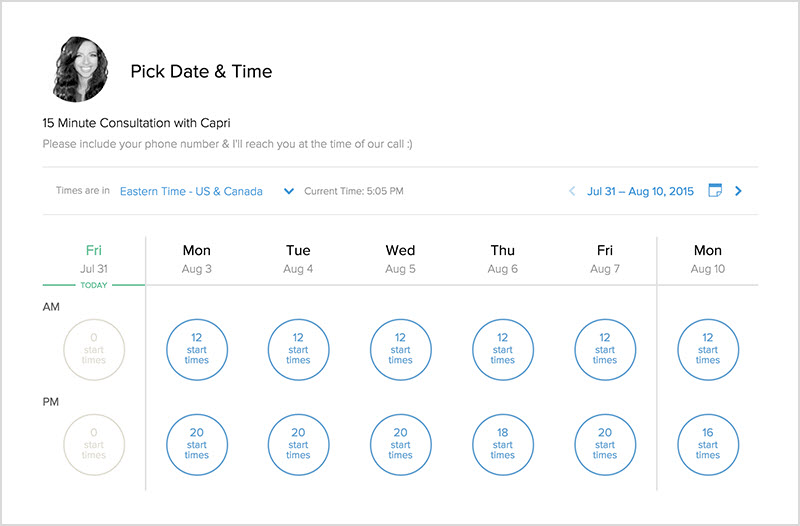
- When setting up your first cold email campaign, it helps to write unique emails to your first 10 or so prospects.
Try to use a slightly different approach, timing and copy for each prospect.
Based on the open rate and response rates of your different approaches, you will see which subject lines work, what calls to action get the most clicks, and when it’s the best time to send the emails.
You can A/B test with GMass or most of the other cold email platforms out there.
- In the last 2-3 emails of your sequence, you could offer a way for prospects to opt out of your emails to avoid annoying those who aren’t interested.
Many outreach automation tools let you insert an unsubscribe link into your emails. Clicking on it removes the contact from your list (similar to email marketing).
Even better? You can use a line like:
No longer interested in hearing from me? Let me know.
Then when the person replies to unsubscribe, at least it shows the email clients like Gmail and Outlook someone replied/engaged with you. That can be a little boost to your sender reputation — might as well get a little good out of the bad news of an unsubscribe.
—
All right, that’s a wrap! These are all the cold email templates and tactics I’ve used for over eight years, and now I want you to do the same!
As always, give me a shout if you have any questions or comments!
- Defining Cold Email
- Is Cold Email Spam?
- Cold Email vs. Unsolicited Email
- Don’t Break the Law with Cold Emailing
- How To Cold Email & Not Send Spam
- Cold Calling Doesn’t Work!
- Cold Emailing is Scalable
- It’s much easier to find (and guess) emails than phone numbers
- Score a $3K Contract Cold Email
- How to Blow Minds w/ Cold Email
- The Best Cold Email Pitch Ever
- How To Land Meetings w/ Cold Email
- Grab a Prospect’s Attention Cold Email
- Win Over a Founder Cold Email
- Score an Interview Cold Email
- Kickstart a Relationship Cold Email
- Land a $15K Project Cold Email
- Grab Potential Customers Early Email
- Connect With a Pain Point Cold Email
- Start a Relationship Cold Email
- Help Someone Out
- Use a Hook in a Cold Email
- Get Published Cold Email
- Win a Backlink Cold Email
- Nail a Sales Call Cold Email
- Cold Email Subject Lines That Work
- More Cold Email Resources
- Cold Email Software: How to Choose Your Platform
- Bonus: Cold Email Pro Tips!
Love these templates! These are the type of templates people need to be using within http://messagesumo.com.
Appreciate you linking to the Cold Email Best Practices guide. Great roundup of examples here!
Happy to do it Justin! Love your content!
P.S. BTW I’ve found a lot of success with this email approach recently: http://www.breakthroughemail.com/coldemailtemplate.pdf
Great detailed beefy post Dmitry.
You mentioned the Breakthroughemail above … looking at your post and the pdf you shared, do you recommend their purchased system, at all?
come again? can your rephrase, I’m not sure I understand you.
Your english sucks 😉
The name Scott takes two “t”. (Paragraph #6, below the screenshot).
No seriously, thanks for sharing. Great post.
Haha, fixed! My pleasure.
Thanks! These are great!
No prob!
Thanks for the awesome post! So helpful. VA recommendations on cold emails are too sales-y to hold my attention. I’ll definitely be referring back to this as a reminder to keep it personal and light.
happy to help!
Way helpful. Thanks mucho!
Great Examples. Cold emails work great. Uber used cold email to launch in Chicago and several other cities. Cold email obviously won’t scale, but it can be extremely effective in developing that early momentum and cultivating early evangelists for your product. Here some good tips listed to write irresistible cold emails. SalesHandy has some amazing blogs on emails.
Great post and examples of excellent, effective emails. Thank you for taking the time to write and share all this. When I started in sales I used similar emails to get appointments, but to further improve my prospecting and appointment setting I would also mail similar letters, personalized. That can stand out. I combined direct mail, letters, post cards, emails and phone calls.
Great article, Dmitry. One (small) observation. In point 12 you mention that Bryan Harris is sending the email. Bryan did not send that one. He is the one receiving it. The one who sends it is Nathan Barry (founder of ConvertKit).
Fixed! Thanks for the spot!
Thanks! This is an awesome resource.
Awesome piece Dmitry! Thanks for taking time to share these tips! However, I want to know what is your take on writing emails to bloggers for your outreach with a casual tone (e.g. using emoji)?
Hey Emmerey, thanks for compliment, glad you liked the article. TO answer your question I don’t typically use emoji in my cold emails, I find them a bit spammy to tell you the truth, that’s just me though haha. They typically work well for newsletters sometimes. What are you trying to use emoji for? Who are you emailing and for why?
whoah this blog is wonderful i like reading your posts.
Stay up the good work! You understand, a lot of individuals are hunting around for this information, you can aid them greatly.
Any company with a dedicated sales team responsible for marketing efforts such as cold emailing potential clients can benefit from these email templates. Thank you so much for sharing such specific details about each one. I often find that making emails conversational in tone, including a clear call to action, and something as simple as proofreading emails before clicking send can also go a long way when it comes to receiving replies in response to what a company has to offer.
Thank you sir, great point on “proofreading” – it’s such an important part of any cold email, spelling mistakes have been shown to decrease response rate by as much as 50% in some studies since the quality of the offer or ask is ill perceived with spelling or grammar issues, or typos.
Excellent post.
Great article, Dmitry!
I recently broke down the best one I’ve received – take a look & let me know if you agree with the analysis (and if you’ve seen a better one): https://www.linkedin.com/pulse/best-sales-prospecting-email-ever-charlie-liang
This is great stuff! Love it! Just tweeted. Thanks for sharing Charlie!
Can’t remember how I stumbled upon this page but it is a goldmine.
So many powerful tips and suggestions I can’t wait to test and try out for some of my sites. Will update you on my progress once I’ve blast some of them out.
Cheers,
Thanks Jonathan! Feel free to come back and let us know how these are working out for you as well as share any new ones you’ve used which work well.
A good way of getting responses is also to use humor. Just read an article about some funny emails here: http://blog.1000leads.co/funny-sales-emails-that-work/
Nice read! Thanks for sharing these! I have some good ones here as well: https://www.criminallyprolific.com/email-endings/
Hi Dmitry
My client was trying her hand at cold emails and it was a collossal fail. Of 263k emails to 3 target segments, there was only 16k opens and no leads generated.
I’m passing this post on to her, there’s some great points here that could have really helped with this campaign.
Thanks for sharing your knowledge.
Awesome! Thanks Tracy. Feel free to have your friend ask any questions as she gets going!
Thanks for showing us how to properly write down cold email templates.
I actually noticed that in the very first example (one of Bryan’s), he writes “video’s” instead of “videos” when he’s clearly talking plural, not possessive.
Hate to say it, but that’s the sort of thing that’s an instant turn-off for me when I get a cold email (sometimes even a non-cold one). When you can’t write about the very thing you’re selling in proper syntax, it makes me wonder just how much of an “expert” you could possibly be!
I have read some articles that suggest the occasional (deliberate) misspelling can be used to convey a sense of a cold email being “genuine” rather than mass/bulk-emailed, and written personally from the sender. An example might be writing “I’m hoping we cna find a time to talk later this week” (cna instead of can). But it’s important to make sure, if doing something like that, that it reads clearly as a typing error and not ignorance/lack of writing skill!
(I’m also not entirely convinced of this tactic, because seriously, who doesn’t have spellcheck?)
Hey Dave, thanks for the shout. I have been on the fence lately with spelling mistakes in emails. Personally I don’t like to see it either. On the other side I have used them much like you suggest in your example and they have helped me get more responses. It also depends what type of outreach you’re doing, if it’s marketing and PR based the tolerance to spelling mistakes might be a bit different from sales outreach. What type of outreach are you doing?
Hi Dmitry, this is a very useful article. Thank you! I just created one cold email. What do you think?
Subject: Valuable content for [name of the site]
Hi Daniel,
I love reading your sales blog posts on xxx site and think you’re providing awesome information that truly helps. Keep up the good work!
My name is Janja and I am an online marketer specialized in content writing. Since I am currently a member of the https://platformax.com CRM team, I do a lot of research and writing on different topics related to business and sales.
I was wondering if you would be interested in me writing a guest post for your blog?
I would be happy to write for you on topics such as sales, management, marketing, team organization etc.
Don’t worry, my guest posts are >1k words, fresh, unique, not keyword overstuffed and above all, they don’t have any toxic links.
In the meantime, you can check one of my blog posts – Five underhand tactics that buyers play on you (linked)
Please let me know whether content like this would be something you’d like to see on your blog.
Looking forward to hearing back from you!
Best Regards,
Janja Jovanovic
[contact information]
Hey Dmitry, your content is a joy to read. Great insights into how to write cold emails to generate leads. Keep up your awesome work!
Thanks for showing us how to properly write down cold email templates. This so useful.
You’re welcome, happy to help. Send over any questions as you modify and try some of these templates out.
Hate to say it, but that’s the sort of thing that’s an instant turn-off for me when I get a cold email (sometimes even a non-cold one). When you can’t write about the very thing you’re selling in proper syntax, it makes me wonder just how much of an “expert” you could possibly be!
I have read some articles that suggest the occasional (deliberate) misspelling can be used to convey a sense of a cold email being “genuine” rather than mass/bulk-emailed, and written personally from the sender. An example might be writing “I’m hoping we cna find a time to talk later this week” (cna instead of can). But it’s important to make sure, if doing something like that, that it reads clearly as a typing error and not ignorance/lack of writing skill!
Remail, for me, is simply the best at what they do. I have tried probably 4 other softwares to see if they can keep out with Remail and I always come back to Remail because I know I can rely on them
Yea, I used to use them a while back, need to take a look at them again. Thanks for the tip.
Wow! Amazing post. This is great. Thanks a million.
Thanks so much for all templates, it’ll be really usefull for me as I am starting my adventure with initial cold mails:) Anyway, another big help for me was coldmail.ai – If you want to check how unique your cold mail is, you shoud visit this platform. It’s free and easy to use.
Thanks for this useful examples!
I have started to work with cold emails few month ago. Need to say, that it was a bit hard for me, but content like this helps me sooo much! I also use some services like Proofy to make my life easier. Proofy is created to check the validity of different email addresses. It’s helpful resource for me, so I would highly recommend it to everyone;)
Ah thanks Diana, yes I use emaillistverify.com for verification but Proofy looks cool. There are so many solutions out there!
Great article! Especially amazing advice about personalization your emails. I’ve found resource that helps you to do it. Remail.io, the main idea is that it’s not look like a robot. Cause I’ve used some email dispatching softwares before and it was awful. But with this one it works! Hope that I was useful for you ?
Remail is a good one, I’ve seen great stuff from them. Will need to give them a try. Have you see Crystal Knows?
I can 100% say that I have deleted every single email I have ever received from anyone following this style of email.
I’m actually surprised to see that it actually works, because all of it, that’s right, all of it, reads completely fake and pandering to me. It makes no sense as to how this even remotely works.
Thanks for sharing great practices and tools! I use Snovio email finder and verifier for marketing automation.Will give a try also to your tools.
I’m putting together my first cold email campaign, and this article is enormously helpful. Thanks.
Thanks for the shout Zev! Happy to help!
LinkedIn is probably the most effective social tool for making new business contacts as well as leveraging your company profile.
This is a great article. You really break down how to construct a cold email and the right approach to getting results. Love it. I wouldn’t use cold email for all outreach but for very specific sales use cases is still works wonders!
I also agree with Andrew. I loved all the examples you have mentioned here. I hope this helps with my own outreach. I am trying to personalize these as much as possible but it’s hard work when you want to scale! Need some good templates!
Thanks for the templates! Nice article to write a quick email from. I wonder which one of these converts the best – I bet the “Appropriate person” email does the best, I know emails such as “quick question” in subject line are the best or “quest question FirstName”?
100%! the subject “quick question” is one of my favorite ones!!! Converts crazy well.
Pure gold!
Your tips have helped me get a near 35% response rate consistently.
Right now our team is using QuickMail for cold email automation, and Limeleads for gathering contact info and contacts.
Do you have any recommendations around other places to buy quality leads? Ideally I’d like to have multiple sources of leads.
Thanks,
-David
Hey David – thanks for the note. Glad you’re getting great response rate. What are you selling BTW?
Re: leads – I usually find my own, too many people selling junky lists.
This is awesome, Dmitry! I’ll be referring back to this regularly as I continue my cold email campaigns.
Glad you love the resource Amy! Thanks for stopping by and please come on back, we love repeat readers and visitors.
Truly epic Dmitry! I can’t wait to put all these templates to use for my business.
But its taking me some time to build a good list of target prospects. Your post on building a media list helped a lot with that.
Would love to share results (or collaborate on writing a case study even) of my email outreach campaign with you, if you’re up for it sometime 🙂
Everything I’ve read cautions against Cold Emailing, not so much because of the content, but rather because the email addresses may be invalid or fake, resulting in high bounce rates. How do you minimize that?
Good question Bob, in most cases I run email verification services on the list to ensure this does not happen. This is a great service – https://www.emaillistverify.com/
Dmitry – this is awesome! Just a great collection of varying approaches. I can’t wait to try these out. I’m in sales for a transportation company. We supply refrigerated transportation to (mainly) farms/packaging facilities, food service companies, and grocery stores. This typically proves difficult since everyone already has a service they are comfortable with. We don’t offer anything new, even though we prove time and again that our service is, indeed, more efficient and, in a lot of circumstances, cheaper. Which of these templates would you lean on to convey understanding of their current situation while still (low-key) boasting about the value that we feel we can add?
Thanks again! BE AWESOME TODAY!!!
Good question Paul, I wonder – is cold email widely used in your industry? I bet your clients don’t get too many cold emails?
What would be your ask, are you asking for a sales call? Do you have content/info/case studies you showcase first? What’s your typical sales process?
This article is fire! I was taking notes and got PAGES of them. Super helpful.
Question. I know you mention email analytics, but also stress the importance of the email being casual and from a person (rather than a machine)… I’m curious if you recommend building a cold email in a regular Gmail/Outlook type app, or if you recommend sending via Mailchimp/Constant Contact etc. since it will give the open, click and other analytics?
Have you found results from sending one way over the other?
Hey Karin,
Good question. I would use something like Outreach.io or Mailshake to do the sending. Definitely do not use Mailchimp for cold email outreach.
-Dmitry
Dmitry, I must sincerely thank you for such a long interesting ride.
I was planning to send out cold emails to potential clients.
This really came in handy.
Thanks for such amazing examples! However, I’m using Pursueapp for for cold emailing as most of my emails earlier were landing in the spam folder of the recipients. But all thanks to PursueApp, now I’m able to generate good sales as well from my cold email campaigns because it has an email verification system which sends my emails directly to the valid leads. Quite impressive features it is having! In case you add some tools, you must take a look at this!